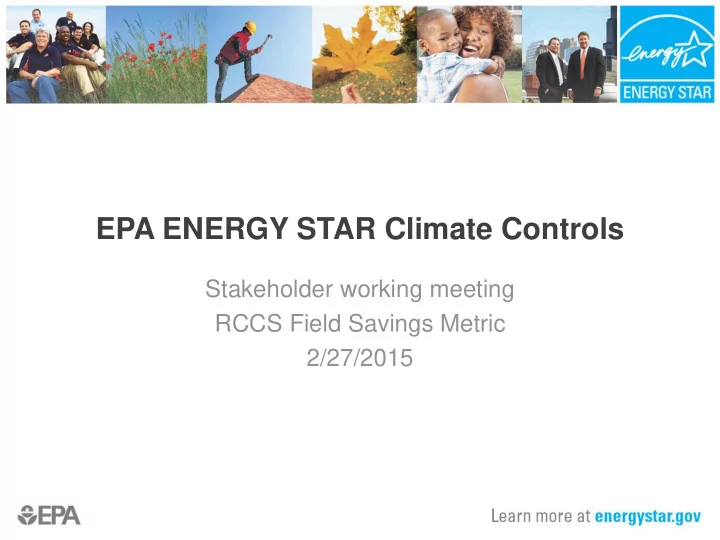

EPA ENERGY STAR Climate Controls Stakeholder working meeting RCCS Field Savings Metric 2/27/2015
Agenda • Reminder of what EPA is aiming for, purpose of the series of meetings (skip if no new participants) • Any administrative issues? • Review of previous topics – Data call – Any comments/feedback on latest metrics doc • Today’s topics to dig in to – Characterizing energy saving control of heat pumps – Multi-stage systems (from parking lot) • Agreed actions • Parking lot review <#>
Introduction – A New Approach • Large potential savings • New product types & business models emerge • Measuring RCCS savings being done today, but… – no standard methodology – savings claims vary widely <#>
Blend of local hardware and cloud services provides RCCS capabilities in the home in the cloud Thermostat Network device Consumer Two-way Remote Demand Occupancy communicatio Access response detection & n Independent Participatio automated Operational of link status Maintain n in 3 rd HVAC status comfort party (e.g. control reporting utility) Control Data services Consumer HVAC collection for feedback Equip. savings RCCS Boundary <#>
Program Outline • Recognition for RCCSs that save energy in the field • To earn the ENERGY STAR: – RCCS criteria that enables savings – Periodic reporting of savings • Product includes service component • ENERGY STAR Partner is service provider • Periodic field data – Calculate program emissions reductions – Serve as energy savings data for QPL <#>
Step 1: Metric • Ranks RCCSs based on field savings • Uses data from RCCS or publically available • Preserves consumer privacy • Protects proprietary information • Practical to calculate • Activities to date – Framework 11/5/14; San Francisco meeting 11/19/14 – Algorithmic framework 1/12/15; Stakeholder call 1/16/15 – Stakeholder call and next algorithmic framework, 1/30/15 <#>
Administrative concerns? • Anything we need to deal with? <#>
Review of previous topics • Data call – Anything unclear? Full data call and correlation of zip codes to climate zones available at energystar.gov and on the Google drive. – When do participants expect to have data for us? • Latest metric doc – Explored the question of calculating daily degree-days using hourly data or daily averages. Any feedback on that point? – Practical question to ponder- if expected to submit summary data including all or most of your installations, could you store a year of hourly data for each and then calculate? Could you store a year of daily data? Or is there a way to do a running calculation? <#>
Focus topics for today – heat pumps • Two weeks ago, we started a discussion of how to characterize how well products were avoiding the use of strip heat. • Last idea we heard was to use compressor utilization (as in the January metrics doc) but report it binned by outside temperature. • Further discussion – daily outdoor temp or hourly? – More computation time? Not significant if using daily average outdoor temp – Look at it a couple ways to decide what is most useful – Recovery from setback? Captured already in set temp savings calc <#>
Focus topics for today – heat pumps • Further discussion – Bins? 5 F bins down to zero F. – Run compressor and strip heat both at the same time – heat pumps continue to provide useful heat (COP > 1) down to 0F – Lockout temp protects compressor against super-cold temperatures – Metric then should be aux heat run time over total heating run time – Will probably include geographic bias because the practice for strip heat installation varies with design temperature • Lockout controlled by thermostat, generally • Hot-humid region heat pumps have heat? <#>
Focus topics for today – multi-stage systems • Ideas for dealing with them – If input power of each stage tends to have a regular relationship to that of other stages (across product models), could do a weighted sum. – Other ideas? • Discussion – For multistage gas furnaces, turn down ratios in fairly narrow range – For stages with essentially the same efficiency – this would not be useful for dealing with strip heat. – For cases where the two stages are the same efficiency, which one runs more doesn’t matter to efficiency – base weighting on efficiency only? <#>
Focus topics for today – multi-stage systems (discussion) – But weighting by energy consumption makes sense for the run time vs. delta T model, and for modeling with run time proportional to energy consumption. – Higher capacity stage may be MORE efficient in actually distributed energy, because for example for low speed, you need to keep the leaky ducts warm all the time. – A good connected thermostat might do something different in a particular home, based on the particularities of the home. – But, would not generally know the input energy of the various stages. <#>
Focus topics for today – multi-stage systems (discussion) – Percent savings from better set point may be the same regardless of the number of stages in a furnace – The percent savings may be more different for multistage compressor system. – In multistage system, you would get two sets of run time data, could analyze them to understand relative size of stages. <#>
Running parking lot • Will providers use this method to make savings claims? • Verification and gaming the system? • Does the customer base bias the metric results, aside from the qualities of the products? • Add on today’s parking lot items… <#>
Contact Information Abigail Daken EPA ENERGY STAR Program 202-343-9375 daken.abigail@epa.gov Doug Frazee ICF International 443-333-9267 dfrazee@icfi.com <#>
Recommend
More recommend